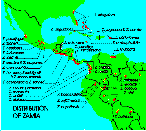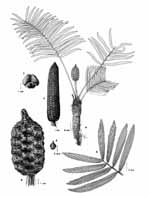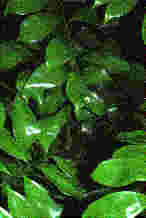
Zamia range map (Jones 1993).

Zamia inermis. a, adult male plant; f, mature megastrobilus; g and h, immature megastrobili [Edmundo Saavedra] (Vovides et al. 1983).

Zamia loddigesii. a, adult female plant; b, foliage detail; c, microstrobilus; d, microsporophyll with microsporangia; e, megastrobilus; f, megasporophyll with two ovules [Elvia Esparaza] (Vovides et al. 1983).

Zamia obliqua [D.L. Jones] (Jones 1993).

Zamia
Linnaeus 1762
Common names
Maw'-ti-ree-na (Kubuyari); koo (Karapaná and Tanimuka) (all are tribes of northwest Amazonia) (Schultes & Raffauf 1990).
Taxonomic notes
The taxonomy of the genus is in a state of flux and "a significant monograph on Neotropical cycads will appear in
Flora Neotropica in the near future." The genus consists of about 55 to 60 species, including about 12 undescribed species (Jones 1993). Fifty-four are listed here; links are included for some of them. Interested readers are referred to the excellent descriptions provided by The Cycad Pages for data on all species of Zamia.
- Z. acuminata
- Z. amblyphyllidia
- Z. amplifolia
- Z. angustifolia
- Z. angustissima
- Z. boliviana
- Z. chigua
- Z. cremnophila
- Z. cunaria
- Z. cupatiensis
- Z. dressleri
- Z. fairchildiana
- Z. fischeri
- Z. furfuracea
|
|
- Z. montana
- Z. monticola
- Z. muricata
- Z. neurophyllidia
- Z. obidensis
- Z. obliqua
- Z. ottonis
- Z. paucijuga
- Z. picta
- Z. portoricensis
- Z. poeppigiana
- Z. pseudomonticola
- Z. pseudoparasitica
- Z. pumila
|
|
Description
"Stems often branched, subterranean to aboveground. Leaves broadly oblong-elliptic; leaflets entire to coarsely dentate, without midribs, venation dichotomous but appearing parallel. Cones distinctly peduncled. Pollen cones more slender than seed cones. x = 8" (Landry 1993).
Distribution and Ecology
Neotropical: USA:Florida, Puerto Rico; Mexico; Central America; South America to Bolivia (Jones 1993).
Remarkable Specimens
No data as of 2023.03.03.
Ethnobotany
Pharmacological studies have found glycosides of methylazoxymethanol, macrozamine and cycasine. Some species are used in Brazil as an antidote to snakebite (Schultes & Raffauf 1990).
Observations
Remarks
First known from 3 species described in lower Eocene deposits in Louisiana, Mississippi and Tennessee (Jones 1993).
Derivation of the name Zamia is "equivocal, perhaps from misreading of Latin azania, a kind of pine cone, or from Latin zamia, loss, from the "sterile appearance" of the pollen cones" (Landry 1993).
Citations
See also
Duncan, W.H. 1979. Zamia (Cycadaceae) new for Georgia. Sida 8:115-116.
Eckenwalder, J.E. 1980a. Dispersal of the West Indian cycad Zamia pumila L. Biotropica 12:79-80.
Eckenwalder, J.E. 1980b. Taxonomy of the West Indian cycads. Journal of the Arnold Arboretum 61:701-722.
Hardin, J.W. 1971. Studies of the southeastern United States flora. II. The gymnosperms. Journal of the Elisha Mitchell Science Society 87:43-50.
Landry, G.P. 1980. The ecology and variation of Zamia pumila L. in Florida. M.S. thesis. Louisiana State University.
Stevenson (1987).
Stevenson, D.W. 1993. The Zamiaceae in Panama with comments on phytogeography and species relationships. Brittonia 45: 1-16. ABSTRACT: A key to, and descriptions of, the eleven species of Zamia in Panama are presented. Four of these are new species: Z. cunaria, Z. dressleri, Z. ipetiensis, and Z. neurophyllidia. Floristically, Zamia is represented in Panama by three elements: three Central American species, Z. acuminata, Z. fairchildiana, and Z. skinneri, which reach their southern limits in central Panama; three northern South American species, Z. chigua, Z. manicata, and Z. obliqua, which reach their northern limits in Panama; and five endemic Panamanian species, Z. cunaria, Z. dressleri, Z. ipetiensis, Z. neurophyllidia, and Z. pseudoparasitica. These distributions are intepreted by a consideration of sister group relationships based upon derived morphological character states.
Ward, D.B., ed. N.d. Rare and Endangered Biota of Florida. Vol. 5. Plants. Gainesville. Pp. 122-124.



